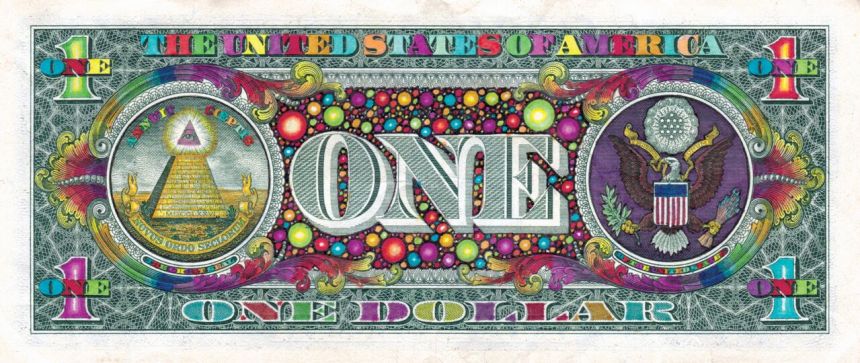Medium and Message: Funny Money at Tregoning & Co.
Josh Usmani’s Funny Money series shows the power of a medium as a kind of collaborator with the artist to give meaning to the work. The series consists of paper currency, which the artist has vividly colored with markers and pens. A new set of these drawings, Altered Value, is on view at Tregoning & Company October 19 through December 8. It comes shortly on the heels of Usmani’s inclusion in the Cash Is King group show at the Saatchi Gallery in London, which brought together currency defaced by artists from around the world. Usmani and Cleveland-based 1984 Publishing released a companion book, Altered Value, the Art of Funny Money.
The timing of the whole series, the first exhibit of which was in 2013, coincides roughly with the rise in popularity of “adult coloring,” wherein people revel in one of the joys of childhood through meditative, perhaps ideally mindless, activity. But Usmani’s work is not that, and the reason is pegged to his use of paper money and the cargo of meaning and value societies give it.
Coloring patterns around pre-printed lines by itself might be child’s play. Using money, though, it becomes a commentary on value, on government, on power, class, and social order. Because the art market is notoriously inequitable and capricious, it is easy to connect these works to that specific subset of the larger economy. It is clearly a criticism, though not a precise or detailed one. Like a burlesque, it is simply making fun. As Usmani has said, he is “putting a clown nose on it.” In the foreward to the book, artist Mark Wagner calls Usmani’s take “sugar coated cynicism.”
Usmani says he began drawing on currency shortly after the economic meltdown in 2008. “By using state-issued bank notes as a medium, instead of paper, paint, or canvas, I encourage my audience to explore their own understanding of value,” Usmani writes in the introduction to the book. Since then he has decorated nearly 200 bills with bright, blooming, swirling patterns. They are mostly US currency, but also currency from around the world.
Back-stories on some of the bills reveal that he has geeked out on the bills themselves, and the history that surrounds them, and the way that connects to his personal situation. For example: “Production problems led to a significant delay and the confinement of more than one billion of these redesigned (Ben Franklin $100) bills. Initially scheduled to be released in early 2011, they were ultimately put into circulation in late 2013,” he writes. That coincided with a commission to draw on one of the new Benjamins. “I didn’t even have $100 to my name,” he continues. “It felt like walking a tightrope without a safety net.”
Some of the bills in the series have been detailed with allusions, if not specific criticisms. The Guy Fawkes mask—made famous by the movie V for Vendetta—appears on several of the presidential portraits through the series, visible in the book, though not in the exhibit. Fawkes, of course, was part of the failed 1605 “gunpowder plot” to blow up the English King James and his Parlaiment to end persecution of Catholics by the king and his government. Since the movie, the mask has been broadly used as a symbol for rebellion against tyrany, especially by anarchist groups.
Also in the book, but not the exhibit, several bills are decorated with the Cleveland Indians’ Chief Wahoo mascott. Usmani says he made one of these on a $20 in response to the argument about removing Andrew Jackson from the bill: In 1830 Jackson “signed the Indian Removal act that led to the Trail of Tears and genocide of countless Native Americans.” The Obama administration would have replaced Jackson with the image of Harriet Tubman, but the Trump administration has no plans to proceed with that plan.
The exhibit Altered Value fills Tregoning and Company’s first two large exhibit areas with a mostly cheery selection of 50 framed bills, some colored with balloon shapes, some with blooming, floral designs, some with geometric patterns, some with a patchwork design, like quilts. The front room is dedicated to US currency. Among these is a $10 with the face of Alexender Hamilton blacked out, which Usmani says is to “encourage reflection on how much we imprint our own identity” onto the Founding Fathers. The most common detail in all the bills is, indeed, a clown nose.
Meanwhile the back room is a world tour of exotic places, with notes from Iran, Iraq, Mexico, Russia, Zimbabwe (a one hundred trillion dollar note!) and other countries.
The book –beautifully designed by Rachel Latina—includes an introductory essay, a Q&A page, commentary on many of the individual notes, an illustration of the stage-by-stage process of coloring a bill, and all the bills the artist could track down and scan: more than 150 images, from what he estimates to be a total of nearly 200 produced so far. And as a complement to the show—the third Funny Money solo show–the book certainly seems like a definitive statement on the project. We can only wonder where the artist goes from here. Usmani says ne’s not sure whether the series will evolve, or whether he will move on to something else. After the Herculean effort to produce the book and exhibit, he needs time to reflect.
Altered Value is on view at Tregoning and Co. through at least December 8. Usmani will be on hand to sell the book during the Cleveland Bazaar December 8 and 9 at 78th Street Studios.







You must be logged in to post a comment.